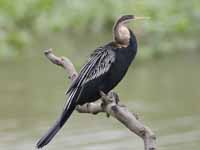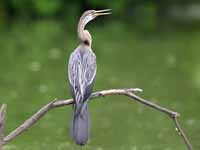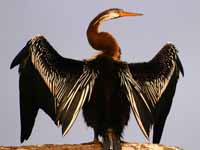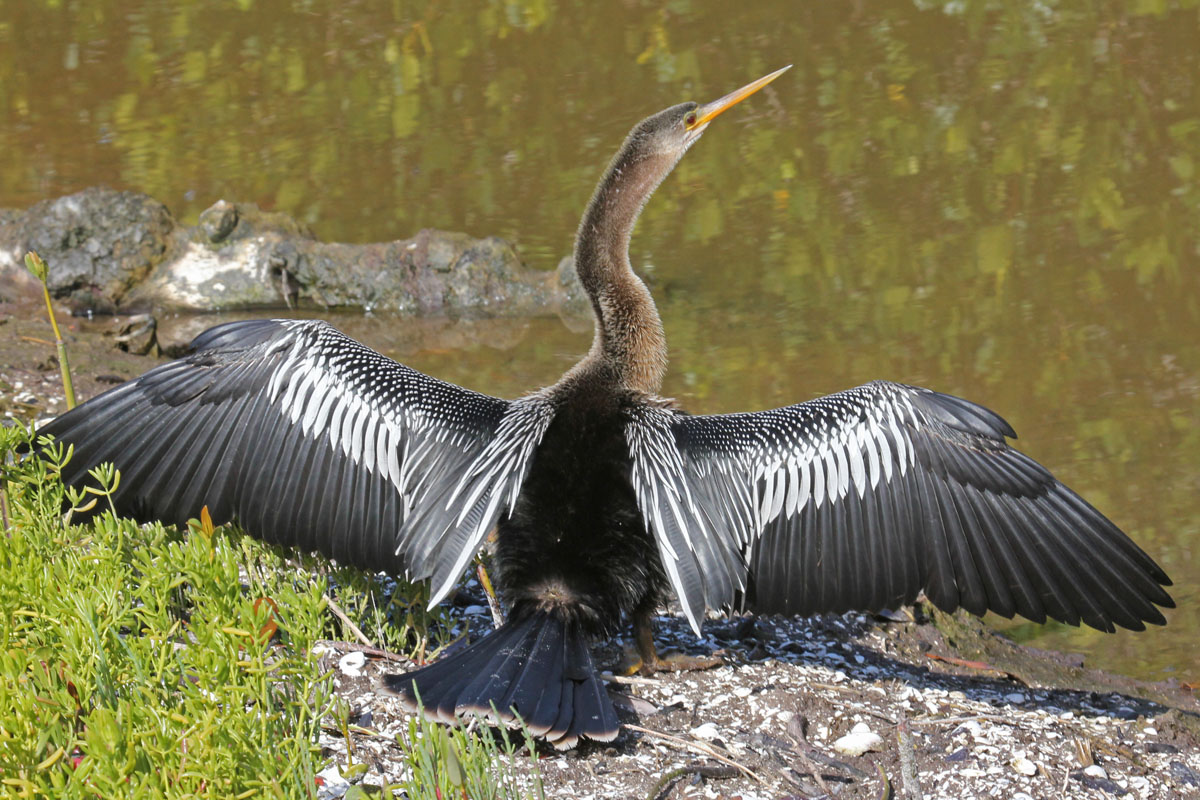THE WORLD BIRDS - An Online Bird Book
SULIFORMES
Anhinga and Darters
Order Suliformes Family Anhingidae - 1 genus
SULIFORMES
The Suliformes order is made up of 4 families: anhingas (Anhingidae), cormorants (Phalacrocoracidae), bobbies and gannets (Sulidae), and frigatebirds (Fregatidae). These are diving birds, they plunge for prey, often from a considerable height. Because of this, their nostrils are protected from water inhalation. For example, gannets nostrils are located inside their mouth. Suliforme chicks are altricial; they are born naked and helpless. Most of the order have large wingspans. An exception is the flightless cormorant of the Galapagos.
Suliformes all have webbing that connects four toes. Ths is also true for pelicans and tropicbirds. They contrast with ducks ang geese that have just 3 webbed toes. Quite recently, all of the suliformes were considered to belong to the same order as the pelicans: Pelicaniformes. Suliformes share another property with the pelicans, they all have bare gular sacs. Of course, this sac has evolved to the extreme with pelicans which use it for fishing.
Suliformes all have webbing that connects four toes. Ths is also true for pelicans and tropicbirds. They contrast with ducks ang geese that have just 3 webbed toes. Quite recently, all of the suliformes were considered to belong to the same order as the pelicans: Pelicaniformes. Suliformes share another property with the pelicans, they all have bare gular sacs. Of course, this sac has evolved to the extreme with pelicans which use it for fishing.
Anhinga and Darters
Order Suliformes Family Anhingidae - 1 genus
Anhingidae and cormorants are extremely similar as regards their body and leg skeletons. But unlike the cormorants, Anhingidae typically inhabit fresh water lakes, rivers, marshes, swamps, and are less often found near salt water. They favor tropical environments. Anhingas have a more pointed bill than cormorants which allows them to spear fish. They have completely webbed feet, and their legs are short and set far back on the body. The males have black and dark brown plumage, a short erectile crest on the nape and a larger bill than the female. The females have a much paler plumage, and are a bit larger overall.
As is true for cormorants, Anhingidae feathers are designed not to be waterproof so the birds can more easily stay submerged. While that is great for chasing prey, it is not good for flying. A saturated bird is heavy and has to expend more energy to fly, that is, if it can get into the air at all. As a consequence, it is very common to see Anhingidae and cormorants with their wings extended to dry.
The Anhingidae is neck long and thin as a result when one is swimming low and mostly submerged in the water it resembles a swimming snake, which leads to their altnernate name the "snakebird". The name "darter" refers to the ability of an Anhingidae to quickly dart its neck forward, thanks to special muscles, so the narrow bill can spear a fish. To aid in their being able to be underwater, the nostrils are in the mouth instead of on their bill. Anhigidae have a small gular sac, much like a pelican's, but minisucle in comparison. During breeding seasons it changes color from pink or yellow to black.
They are colonial breeders. The male usually brings twigs, leaves and other nesting material to the female and she makes the nest. They both incubate the eggs and feed the chicks. Their food is regurgitated partly digested fish. After they fledge, the chicks are taught to fish and then after about two weeks they fish for themselves.
Genus Anhinga
Anhingas and Darters
Anhinga Anhinga anhinga
Description: The anhinga has glossy black upperparts with white streaking on the upper wings; grey elongated feathers on head, neck. The neck is long and thin, which leads to its alternate name the snakebird. The anhinga is 75 to 95 cm long. The similar double-crested cormorant has a thicker neck. Also, the anhinga's bill is thin and pointed while the double-crested cormorant's is thicker and hooked at the end.
Range: Southeast United States to Panama, and much of South America.
Habitat: Slow moving and usually freshwater.
Diet: Mainly fish; also aquatic insects, snakes, frogs.
Conservation status: Least Concern.
Image by: 1, 2) Dick Daniels - Ding Darling National Wildlife Refuge, Florida 3, 4) Dick - Jacksonville, FloridaRange: Southeast United States to Panama, and much of South America.
Habitat: Slow moving and usually freshwater.
Diet: Mainly fish; also aquatic insects, snakes, frogs.
Conservation status: Least Concern.
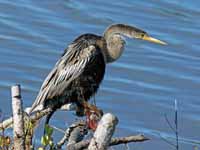
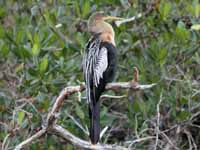
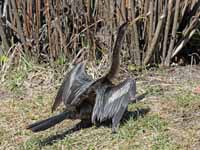
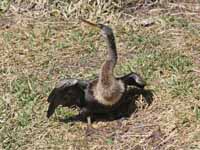
Darter, African Anhinga rufa
Description: The male African darter has glossy black upperparts with white streaking plus white streak below and behind the eyes. Females and juveniles are browner. The African darter is 80 cm long.
Range: Sub-Saharan Africa, Madagascar.
Habitat: Slow moving and usually freshwater.
Diet: Mainly fish; also aquatic insects, snakes, frogs.
Conservation status: Least Concern.
Image by: 1) Arno Meintjes 2) Stickpen - San Diego Zoo, California 3) Hans Hillewaert - Livingstone, Zambia 4) Jazon Wharam - ZimbabweRange: Sub-Saharan Africa, Madagascar.
Habitat: Slow moving and usually freshwater.
Diet: Mainly fish; also aquatic insects, snakes, frogs.
Conservation status: Least Concern.
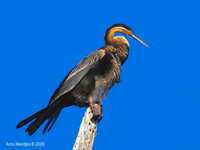
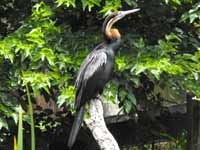
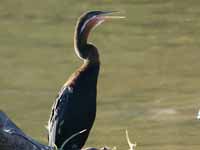
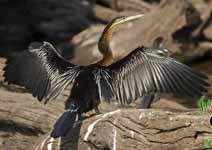
Darter, Australasian Anhinga novaehollandiae
Description: The Australasian darter has mainly black plumage. He also has a white streak below and behind the eyes, plus there are small white streaks on the wing coverts. The female is similar with a paler neck and white underparts. The Australasian darter is 85 to 95 cm long.
Range: Australia, New Guinea.
Habitat: Slow moving and usually freshwater.
Diet: Mainly fish; also aquatic insects, snakes, frogs.
Conservation status: Least Concern.
Image by: 1) Scarlet23 - Perth Zoo, Western Australia 2) Toby Hudson 3) Dick Daniels - Manly, Australia 4) Dominic_SheronyRange: Australia, New Guinea.
Habitat: Slow moving and usually freshwater.
Diet: Mainly fish; also aquatic insects, snakes, frogs.
Conservation status: Least Concern.
1, 2) Female or juvenile 3) Female 4) Male
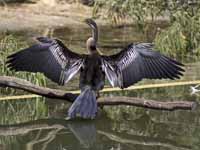
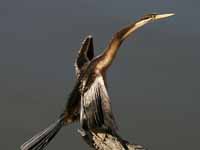
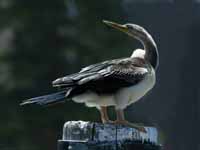
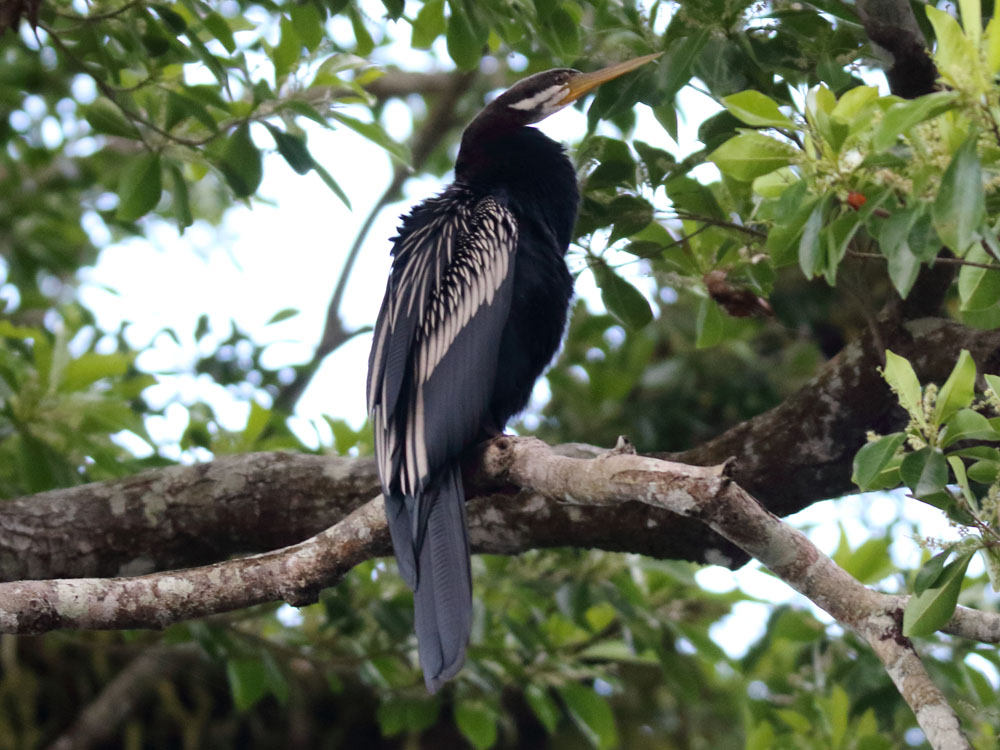
Darter, Oriental Anhinga melanogaster
Description: The Oriental darter has black upperparts with silver streaks on the wing coverts. It has brown shading to the crown and neck. The iris is white iris and there is a yellow eye-ring. It has a white streak below and behind the eyes The underparts are blackish-brown. The Oriental darter is up to 97 cm long.
Range: Indian Subcontinent, Southeast Asia.
Habitat: Slow moving and usually freshwater.
Diet: Mainly fish; also aquatic insects, snakes, frogs.
Conservation status: It is listed as Near Threatened because of a declining population from pollution and hunting.
Image by: 1) Lip Kee - India 2) Koshy - India 3) KalppallyRange: Indian Subcontinent, Southeast Asia.
Habitat: Slow moving and usually freshwater.
Diet: Mainly fish; also aquatic insects, snakes, frogs.
Conservation status: It is listed as Near Threatened because of a declining population from pollution and hunting.
